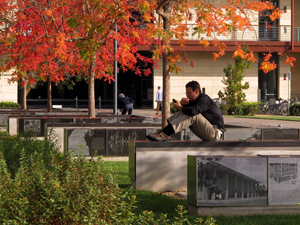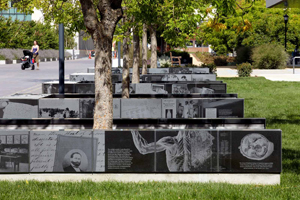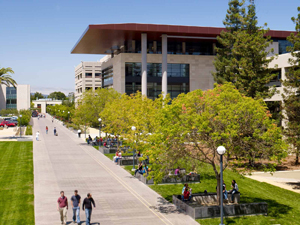April 23, 2012 - By Tracie White

An outdoor installation honoring Stanford’s contributions to the advancement of medicine will have its official debut on May 5. Dean Philip Pizzo, artist Susan Schwartzenberg and landscape architect Tom Leader will speak at the ceremony.
When Philip Pizzo, MD, dean of the medical school, first came to Stanford University, he noted how little homage was paid to history or the past compared with the East Coast universities he came from.
“Unlike the East Coast, where portraits and history abound, virtually none of that was found at Stanford,” Pizzo said. “That reflects the culture of looking forward and not dwelling in the past. That is a great value at Stanford, which I respect.”
At the same time, the dean felt it was important to honor the medical school’s unique history and the remarkable achievements of its faculty, in conjunction with the building of the new Li Ka Shing Center for Learning and Knowledge, which now serves as the gateway to the School of Medicine. And he wanted to place these accomplishments in the context of the broader history of modern medicine.
Thus was born the concept for the “Discovery Walk” — a promenade that stretches across the entire length of the medical school campus commemorating major advances in medical science, made by scientists at Stanford and beyond, over the last 150 years. The outdoor art installation tells these stories of medical research, in words and images, all etched on black granite panels that line a series of benches along the walkway.
An official dedication ceremony will be held 1:30 p.m. May 5 at the Albert Yu and Mary Bechmann Plaza outside the center. The ceremony will feature Pizzo; the visual artist who designed the exhibit, Susan Schwartzenberg; the project’s landscape architect, Tom Leader; and alumnus Ross Bright, MD. Schwartzenberg will also lead a tour of the installation after the ceremony.
Schwartzenberg, whose art explores themes of history and memory, has done public projects in Los Angeles, Phoenix, San Francisco and Seattle. She also works as a senior artist at San Francisco’s Exploratorium museum.

The walk features etched panels of black granite — from a quarry in Mongolia — depicting the history of modern medicine.
The new installation consists of 22 benches with 347 panels, made of a clear black granite imported from a mountaintop quarry in Mongolia. It is landscaped with pastiche trees, flowers and a medicinal herb garden. The first five benches have panels covering the medical school’s history, from its origins in 1858 to the present; the remainder delve into such subjects as the sequencing of the genome, the discovery of stem cells, the development of the linear accelerator to treat cancer and research on cardiovascular disease and transplantation.
Each of the 20-by-30 inch panels uses text and images to tell a story. Reproduced in the stone are an fMRI scan of a brain, a double helix of DNA, old newspaper clippings, an enlarged microscope slide showing a leukemia cell, an excerpt of the late biochemistry professor Arthur Kornberg’s remarks on being awarded the Nobel Prize and more. In the space of roughly one city block is more than a century’s worth of medical science.
The text and images were developed from countless hours of research that involved sifting through oral histories, artifacts and photographs and conducting interviews with some 200 faculty members, staff and alumni, records of which are now archived in Lane Medical Library.

Discovery Walk stretches from the Clark Center to the Lokey Stem Cell Research Building.
“The project allows visitors to the campus and incoming students to get a sense of what is going on there — what kinds of research questions are being asked,” said Schwartzenberg. “I also hope it humanizes science as many of the faculty interviewed are very open about their doubts, successes and failures, as well as explaining why they are so intrigued and committed to the work they do.”
The idea for the project arose from conversations in 2007 among the dean, project manager Maggie Saunders and the Li Ka Shing Center’s architectural firm, NBBJ. To determine which bits of history to include from the vast amount of science done at the medical school, the project team sought input from hundreds of faculty. While the artists led the project, the dean was its sponsor and the final editor of its content. He suggested many of the individuals who were interviewed, and reviewed each phase, commenting on the panels in their various iterations.
And the work isn’t over. “I hope that this will continue to evolve and develop over the life of the school and university,” Pizzo said.
About Stanford Medicine
Stanford Medicine is an integrated academic health system comprising the Stanford School of Medicine and adult and pediatric health care delivery systems. Together, they harness the full potential of biomedicine through collaborative research, education and clinical care for patients. For more information, please visit med.stanford.edu.